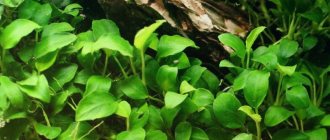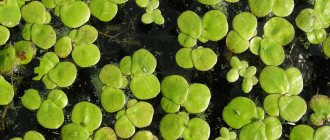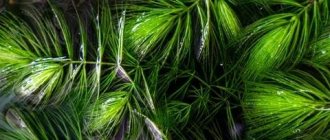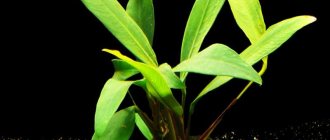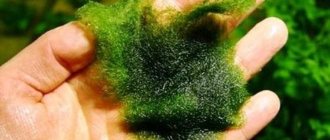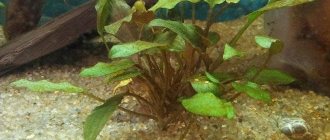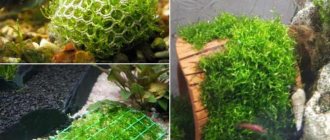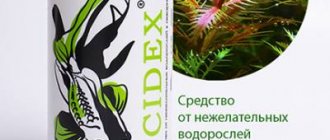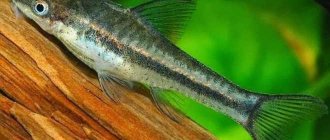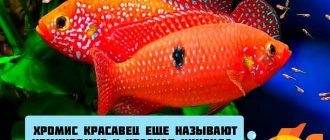The aquarium plant Schisandra is very popular among breeders of ornamental fish. Beginners involved in aquarium farming successfully create their own ecosystem at home by planting this particular vegetation. It is easy to care for, has fast growth and an attractive appearance.
Schisandra grows quickly and is unpretentious in maintenance.
Brief description and appearance
The algae Schisandra, or Indian great swampweed, is officially called in Latin as Nomaphila stricta. The plant is a member of the Acanthus family and exudes a subtle citrus aroma .
The described plant produces a long and fairly strong straight stem. It is bordered by oval leaves with slightly pointed edges, painted in light green shades and having pronounced veins. The leaves are attached to the base in pairs, grow up to 10-12 cm in length, and reach an average width of 3-5 cm. During the flowering period, small bluish inflorescences appear.
Having reached the surface of the water surface, lemongrass spreads out on it, the leaves acquire characteristic roughness and corrugation, and do not lose their decorative properties. The algae is adapted for living in a water-air environment. It takes root well in an aquarium and feels good in a paludarium.
Peculiarities
Schisandra, one of the types of aquarium plants, got its unusual name due to the special smell it emits. The aroma itself is weakly expressed and vaguely reminiscent of lemon. But it is also worth noting that there is another name for this plant - Indian swampweed or Nomaphila stricta. It comes from Asia, more precisely, from its southeastern part.
One of the main functions of the plant, in addition to aesthetics, is oxygen saturation of the aquarium space. In addition, the large leaves of the plant can serve as an excellent shelter for fish. It is also worth noting that this vegetation can grow both in water and on land, provided that the humidity is optimal for growth .
Moreover, in air the growth rate can be several times faster.
This plant is capable of pleasing the eye for a long time, since under good conditions, aquarium lemongrass can grow for 365 days a year, approximately 10 centimeters in one week. Please note that if the growth of the plant is not controlled, it can grow greatly and take up more space in the aquarium than it should.
Common varieties
Serious competitors of ordinary lemongrass are Nomafila serrata and Nomaphila thailandica. They are often the choice of discerning aquarists:
- Toothed algae has leaves with a sparser arrangement, on the edges of which there are pointed formations. Because of this feature, the plant does not require a lot of bright light. The leaves of Schisandra angustifolia, located in the upper part, do not create a strong shadow, so the lower branches receive enough light.
- The Thai variety always looks elegant in an aquarium. It is distinguished by small leaves that densely cover the stem. The general shape of this algae is very similar to a branched and lush shrub.
How to reproduce?
As for breeding this type of plant, it is done using cuttings. In order to carry out all processes correctly, you need to follow certain instructions.
First, separate the upper shoots of already mature lemongrass and plant them in fine soil; pebbles are also sometimes used. When cutting the top part, side shoots are obtained, which should also be separated and planted in fine soil or pebbles. Thus, provided that the root and part of the stem are preserved in the soil, you can get an aquarium lemongrass plant with side shoots.
As soon as the process of self-propagation of the plant is completed, you can begin planting your “pet”. If you have been breeding aquarium lemongrass yourself at home, then after planting it, you should closely monitor its “health” for a while so that in case of any problems your plant does not die.
As soon as you notice changes in the appearance of the plant, this is direct evidence that the living conditions of the lemongrass are not entirely suitable for it, and something needs to be changed.
See the video below for more information about the aquarium plant Schisandra.
- Author: Maria Sukhorukikh
Rate this article:
- 5
- 4
- 3
- 2
- 1
(0 votes, average: 0 out of 5)
Share with your friends!
Natural habitat
Under natural conditions, the plant is found throughout Southeast Asia. As a semi-aquatic algae, it grows in small streams, and as a representative of marsh flora, it is present on the banks of larger bodies of water.
Straight nomaphyla Schisandra is distinguished by a cross-shaped arrangement of leaves , which create bizarre natural patterns. There is a version that it is precisely this feature that is the basis for the origin of the plant’s name in Latin. The word "nomos" is translated as "law" or "order".
https://youtube.com/watch?v=ive8zrCboe4
Nomaphyla longifolia
Schisandra nomaphila longleaf photo
In addition to the popular form of nomaphila - schisandra, nomaphila longleaf (commercial name - Nomaphila sp. "Long leafed") is sometimes found in hobby aquariums. Externally, this plant is very similar to Hygrophila angustifolia. Even experienced aquarists are not always able to distinguish them. The conditions for keeping the plant are approximately the same as for lemongrass. But it is less demanding on lighting due to the highly elongated leaf blade, which overlaps the lower leaves to a much lesser extent. The plant retains its lower leaves much longer in medium-hard water with a lack of light.
Schisandra nomaphila longifolia photo
Just like Schisandra, Nomaphila longifolia, having reached the surface of the water, easily comes out into the air, but its appearance undergoes significant changes: the leaves are shortened. are made more dense. the stem becomes pubescent. Reproduction proceeds like that of lemongrass. Plant cuttings transferred from the paludarium to the aquarium easily adapt and take root.
Difficulties of care
Keeping lemongrass in an aquarium, provided favorable conditions are provided for it, does not cause any trouble. Intensive growth of shoots is noted, and the green mass grows so quickly that in the absence of regular mowing, it will occupy all the free space of the artificial reservoir. It is more convenient to control the growth process if the algae is planted not in the aquarium soil, but in a special clay pot. It will prevent rapid development of the root system while ensuring moderate growth of the green part.
Important! Choosing a pot that is too large for planting is the wrong decision. The development of the above-ground part will stop completely, since all activity will focus on growing the rhizome.
With proper, consistent pruning of the plant, it can be given the desired shape. The side shoots will stretch to the sides, creating a lush and attractive bush.
Schisandra aquarium plant in open ground
Contrary to book recommendations, I acted differently and did not transplant Nomaphyla into a wet greenhouse or paludarium, but transplanted it into open ground. Does nomaphila grow in air above water and not die? I cut two plants growing above the water and transplanted them into a plastic container.
As a nutrient soil, I used garden soil with a layer of 8-10 cm, and so that the plant had enough moisture, and it did not dry out and took root faster, I filled the free space in the container with water. A week has passed. My aquarium plant Schisandra grows on a windowsill in the open ground and feels great.
join the discussion
Share with your friends
The aquarium plant Schisandra has been a popular resident of the aquarium for quite a long time. With the help of this plant, every fish owner can easily create their own ecosystem. Aquarium lemongrass is quite unpretentious in maintenance, distinguished by its rapid growth and special beauty. You will learn about all the other features of the plant and much more from our article.
Stay in the aquarium
A well-growing lemongrass will wither and lose its natural attractiveness in a small container of water. Experienced aquarists say that it should be placed in a jar with a volume of 150 liters or more. If you have a container of more modest size, you should limit yourself to one shoot of the plant, and not a group, as is usually planted to create a complete picture of a natural area. A luxurious green background is provided by placing seaweed along the back wall.
Tropical grass feels comfortable at high water temperatures, ranging from +24 °C to +28 °C . If this requirement is overlooked and the temperature of the aquatic environment drops several notches from the given lower limit, Schisandra will completely stop growing. When the water cools to +20 °C, it will simply die.
Strict requirements are put forward for the water composition of the nomaphila habitat:
- acidity is within pH 7-8.5;
- the amount of nitrates does not exceed 10 mg per 1 liter of water;
- moderate hardness.
A sharp change in the indicated characteristics can negatively affect the grass, which exhibits increased sensitivity to all kinds of chemical compounds.
Advice! In a highly softened aquatic environment, lemongrass often sheds its lush leaves, leaving a completely bare stem, decorated with an upper crown of small shoots.
Schisandra grows well at a water temperature of +24-28C.
Regular feeding of the plant is recommended, based on magnesium, calcium, and phosphorus. Otherwise, the raging greenery will quickly wither and fade, taking on an unpresentable appearance. The leaves may curl and become covered with unpleasant brown spots.
If such signs are present, it is recommended to immediately feed the aquarium by adding complex fertilizer to the aquarium. Changing the conditions of maintenance should be carried out gradually; the described grass, although unpretentious, reacts painfully to sudden changes and requires a certain adaptation period.
Choosing the right soil is an important component. Nomaphyla takes root quickly and exhibits intensive growth when choosing the right soil . It should be:
- volumetric (height - from 5 cm);
- moderately silted;
- enriched with nutritional components.
Important! When planting grass, a small clay pillow is laid under the rhizome, which serves as a kind of support.
A tropical plant, accustomed to the merciless sun, needs sufficient lighting. For these purposes, special fluorescent lamps are often installed in aquariums. The optimal power calculation is half a watt per 1 liter of water. It is not difficult to make correct calculations taking into account the volume of a homemade jar of fish.
Schisandra loves light and often needs additional lighting.
The supplied artificial light should reach the algae from all directions for 12 hours during the day. Side lighting will ensure the normal development of the lower leaves, thereby maintaining the elegant appearance of the greenery.
Interesting! Determining sufficient illumination is extremely simple, this will be indicated by the rich brown color of the main stem.
A tropical aquarium is subject to constant powerful filtration, for which a standard mechanical device with a foam component is suitable. This filter pumps water quickly. To prevent its jets from damaging the delicate leaves of nomaphila under pressure, it is recommended to equip a deterrent in the form of a wide waterfall.
In a sparsely populated aquarium where there is a large colony of Schisandra, no additional aeration is required. The algae independently regulates the level of oxygen and carbon dioxide.
In some cases, ground planting of lemongrass is practiced, which takes root well in humid greenhouses. Initially, it is planted in a jar with a small volume of water. When aerial shoots appear, it moves to a flower pot.
Aquatic Compatibility
Keeping an aquarium plant Schisandra is not difficult. But you should remember about its worst enemy - the Ancistrus fish, another name for which is the cleaner catfish. She eats the lush green foliage of the grass with great pleasure, hopelessly spoiling its appearance. As for the neighboring plants, no enemies of nomaphila were noted among them.
The exception is the adaptation of tropical grass to the more severe, “Spartan” growing conditions of other representatives of the flora. For this reason, the correct selection of plants and animals for living together in the aquarium is carried out, for which the same conditions are favorable.
The peculiarity of lemongrass is its violent growth in all corners of the “glass house ,” which can inhibit the development of other algae. The way out of this situation is to regularly trim the shoots of nomaphila and maintain a certain distance between the green pets planted in the water.
Important! Placed in an aquarium, Pistia throws out large rosette leaves drifting on the surface. It is necessary to ensure that there is free space for schisandra shoots, which must be in contact with air.
Schisandra grows very quickly and can interfere with the growth of other plants.
Prevention and treatment of diseases
Tropical algae get sick when created inappropriate conditions. Evidence of this process is a sharp deterioration in growth and general development, a change in bright color to dull and unsightly shades. Diseases progress against the background of the following factors:
- Low temperature indicator - stunting of growth, the appearance of small and excessively fragile shoots.
- The soil layer is too thin to strengthen the rhizome. Causes poor grass development.
- Increased water softness. Involves complete destruction of green space.
- Deficiency of nutritional components. Helps change the natural color of leaves. Lack of lighting causes the leaves to die, the process begins from the bottom.
Important! When nomaphila is diseased, it will not bloom, but its inflorescences are a unique natural decoration for the aquarium.
https://youtube.com/watch?v=SOcwKnHS8TU
Lifespan
It is impossible to define a strict life framework for ornamental tropical algae. If proper care is provided for the green space, a continuous cycle of succession occurs, during which adult shoots are gradually replaced by new shoots, and the plant does not lose its decorative properties.
Interesting fact! Schisandra does not know “hibernation” or “oppression”; it is not tied to the change of seasons. Growth and development continues all year round.
Description
Aquarium lemongrass grows all year round under good conditions. The life cycle repeats itself for decades. It grows quickly, adding up to 10 cm per week. If growth is not controlled, lemongrass will take up a lot of free space.
Appearance
The height of lemongrass is up to 30 cm. The leaves are oval, pointed. The length of the light green leaves is 10–12 cm, width - up to 4 cm. The back side of the leaf is silvery. The stem is thick and darker than the leaves. The aquarium plant lives in water and on land with sufficient humidity. At the same time, lemongrass grows faster in air. The leaves rising above the water are distinguished by relief and clear veins. Flowering is accompanied by the appearance of a small blue flower above the surface of the water.
Lifespan
If the correct conditions are maintained, the aquarium plant will delight you for many years.
About 10 varieties of lemongrass are known. Only 3 are common in aquarium conditions.
- Longleaf. A tall plant, bred artificially. The leaf shape is oblong. A hardier form of lemongrass. Outwardly it resembles Hygrophila angustifolia.
- Serrated. The dark leaves are edged with small teeth and are spaced less frequently than those of other species of lemongrass.
- Thai.
A variety that forms dense bushes due to the dense arrangement of leaves.
Features of reproduction
Nomaphila is characterized by cuttings , which involve cutting off the upper part of the shoot and then planting it in the ground. In order to prevent fish from digging up the shoot, it is recommended to initially place it in a separate small pot. After rooting, the grass moves to its permanent location.
Schisandra is not tied to the changing seasons and grows constantly.
There is an easier way to propagate lemongrass. Its stalk can be left floating on the surface of the water. But at the same time, a curved stem is likely to develop, since all the leaves will be drawn towards the light.
Reference! Cuttings do not inhibit algae. On the contrary, it rejuvenates and actively throws out shoots to the sides and bushes intensively.
Schisandra is an excellent option for arranging a home aquarium. It always looks fresh and attractive, creating a separate tropical atmosphere in the room. The main positive aspects are the unpretentiousness of the plant if the minimum basic conditions are created for it.
Reproduction
Schisandra propagates by cuttings. Cut off the top shoot and place it in the ground. To protect developing roots from being dug up by aquarium fish, place the plant in a pot. For planting, select a small container, otherwise the nomafila will develop a root system without growing tall. The cutting can be left unrooted, but the resulting shoots may grow uneven.
I remember the aquarium plant Schisandra from childhood. Many years have passed since then, but Schisandra still decorates aquariums without losing its popularity. Popularity does not come to plants just like that; it is given for their positive qualities, among which unpretentiousness and decorativeness are of paramount importance. But even unpretentious species need favorable conditions, without which the plants will not be able to grow well and will never show all their charm.
